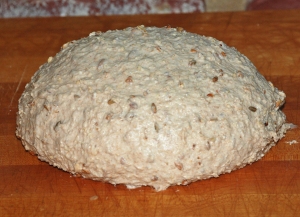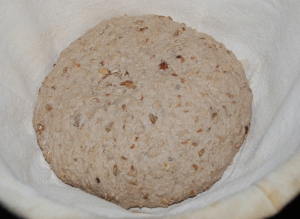 This ain't your Momma's traditional cornbread, but if you want to try a great tasting bread with a nice sourdough twang, and corn flavor then read on.
This ain't your Momma's traditional cornbread, but if you want to try a great tasting bread with a nice sourdough twang, and corn flavor then read on.
I just returned from my trip to North Carolina to celebrate my Father-in-law's 80th birthday. My wife and myself cooked up a storm but unfortunately I didn't have time to make any bread for the occasion so I'm itching to get back to my bread making.
I decided to try adapting a recipe I found on the www.thefreshloaf.com from Steve B. at www.breadcetera.com for a Corn Bread made with a poolish starter. I used my sourdough starter in place of the poolish and also eliminated the yeast from the recipe. I used my usual baking method borrowed from Peter Reinhart's Artisan Breads Everyday and the results were excellent if I do say so myself!
Corn flour is used along with All Purpose flour and since the corn flour does not have the ability to form gluten the resulting bread has a pretty tight crumb. I tried my best to copy the stenciling design done by Steve B. and I think it came out pretty close.

Final Dough
15.80 ounces Refreshed White Starter, 68% hydration (approximately 6.8 oz. water, 10.5 oz. All Purpose Flour, 3.7 ounces starter)
14 oz. Water (90 degrees F)
16 ounces All-Purpose Flour (I used King Arthur's)
8.95 ounces Corn Flour
3 Tsp. Salt (sea salt or table salt)
3 Tbs. Olive Oil
Directions
For the final dough, using your stand mixer or by hand, mix the water with the refreshed starter to break it up.
Add the flours, salt, and olive oil and mix on the lowest speed for 2 minutes. Let rest for 5 minutes.
Mix for 4 minutes more on medium speed, adding more flour if necessary to produce a slightly sticky ball of dough.
Remove dough to your lightly floured work surface and need for 1 minute and form into a ball.
Leave uncovered for 10 minutes.
Do a stretch and fold and form into a ball again and cover with a clean moist cloth or oiled plastic wrap.
After another 10 minutes do another stretch and fold and let it rest again for another 10 minutes. Do one last stretch and fold and then put it into a lightly oiled bowl that has enough room so the dough can double overnight.
Let the dough sit in your bowl for 2 hours at room temperature. It should only rise slightly at this point. After the 2 hours are up put it in your refrigerator for at least 12 hours or up to 3 days.
When ready to bake the bread take your bowl out of the refrigerator and let it sit at room temperature for around 2 hours. After 2 hours shape the dough as desired being careful not to handle the dough too roughly so you don't de-gas it.
Place it in your bowl, banneton or shape into baguettes.
Let it sit at room temperature for 2 hours covered with oiled plastic wrap or a moist cloth.
Pre-heat oven with baking stone (I use one on bottom and one on top shelf of my oven), to 500 degrees F.
If you want to make the fancy "Corn Stalk" design, cut a strip of paper and place it on the middle of the round dough and sift a light dusting of flour over the dough. Next make 3 slashes on both sides of the "stalk" and then place an empty pan in bottom shelf of your oven.



Pour 1 cup of very hot water into pan and place loaves into oven. I also prefer to use a water bottle and spray the sides of the oven 2 times at 3 minute intervals to add some additional steam.
Lower oven to 450 Degrees and bake for 25 - 35 minutes until bread is golden brown and the internal temperature reaches 200 degrees.
Shut the oven off and leave the bread inside with the door slightly open for 10 minutes. This will help dry the loaves out and keep the crust crunchy.
Let cool on cooling rack and enjoy!
As you can see the crumb is very tight which is mainly due to the corn flour. When I make this bread again I would try to add some fresh roasted corn to give it an added boost of corn flavor.


This post has been submitted to the Yeast Spotting Site here: http://www.wildyeastblog.com/category/yeastspotting




































